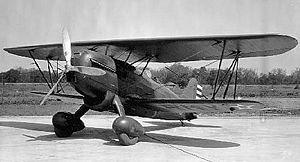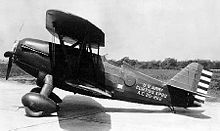- Curtiss XP-22 Hawk
-
XP-22 Hawk Role Experimental biplane fighter Manufacturer Curtiss Aeroplane and Motor Company Primary user United States Army Air Force Number built 1 Variants Curtiss P-6 Hawk The Curtiss XP-22 Hawk was an 1930s American experimental biplane fighter built by Curtiss for evaluation by the United States Army Air Service.
Contents
Design and development
In 1929, the AAC ordered three P-11 Hawks for testing of the 600 hp (447 kW) H-1640 Chieftain engine. This engine proved a failure, and before completion, one of the three was converted to use a 9-cylinder 575 hp (429 kW) Cyclone, being completed as the YP-20. Testing with the R-1820 was prolonged, so the Army acquired another of the three P-11s, instead. This became the XP-22.
A number of changes were made for installing the 700 hp (520 kW) Curtiss V-1570 Conqueror engine. The radiator was relocated, a new cowl was fitted, and the tail was given more fin and less rudder area,and featured a steerable tailwheel, rather than the original skid. For these changes, Curtiss charged only US$1.[1]
During testing, the XP-22 underwent a number of alterations and improvements, including a change from a three-strut landing gear to a single streamlined strut, later fitted with wheel pants. Fillets were added where struts joined the wing and the tail was briefly reduced in area, to P-6 standard.[1] The XP-22 was also the Army's first fighter capable of 200 mph (320 km/h), achieving 202 mph (325 km/h).[2]
Operational history
In June 1931, the AAC held a competition to evaluate the P-6, P-12, YP-20, and XP-22. The XP-22 came out the winner, earning a contract for 45 aircraft as the Y1P-22. Following the trials, the XP-22 donated a nose and landing gear graft to the YP-20, which became the XP-6E, and the 45 production aircraft were completed to this standard.
Operators
- United States Army Air Force
Specifications
Data from U.S.Fighters[2]
General characteristics
- Crew: one pilot
- Length: 23 ft 7 in (7.2 m)
- Wingspan: 31 ft 6 in (9.6 m)
- Height: 8 ft 10 in (2.7 m)
- Wing area: 252 ft² (23.41 m²)
- Empty weight: 2,597lb (1,178 kg)
- Max takeoff weight: 3,354 lb (1,521 kg)
- Powerplant: 1 × V-1570 Conqueror water-cooled 12-cylinder vee engine, 575 hp (429 kW)
Performance
- Maximum speed: 202 mph (176 kn, 325 km/h)
- Service ceiling: 26,500 ft (8,077 m)
References
- Notes
- Bibliography
- Donald, David, ed. Encyclopedia of World Aircraft. Etobicoke, ON: Prospero Books, 1997. ISBN 1-85605-375-X.
- Fitzsimons, Bernard, ed. "Hawk, Curtiss Models 34 and 35 P-1 to P-6 and F6C". Illustrated Encyclopedia of Weapons and Warfare. Volume 12, pp.1255-6, London: Phoebus Publishing, 1978.
- Jones, Lloyd S. U.S. Fighters: 1925-1980s. Fallbrook, California: Aero Publishers, Inc., 1975. ISBN 0-8168-9200-8.
USAAS/USAAC/USAAF/USAF fighter designations 1924–1962 Pursuit (pre-1948)
Fighter (post-1948)P-1 • P-2 • P-3 • XP-4 • P-5 • P-6 • XP-7 • XP-8 • XP-9 • XP-10 • P-11 • P-12 • XP-13 • XP-14 • XP-15 • P-16 • XP-17 • XP-18 • XP-19 • YP-20 • XP-21 • XP-22 • XP-23 • YP-24 • Y1P-25 • P-26 • YP-27 • Y1P-28 • P-29 • P-30 • XP-31 • XP-32 • XP-33 • XP-34 • P-35 • P-36 • XP-37 • P-38 • P-39 • P-40 • XP-41 • XP-42 • P-43 • P-44 • XP-45 • XP-46 • P-47 • XP-48 • XP-49 • XP-50 • P-51 • XP-52 • XP-53 • XP-54 • XP-55 • XP-56 • XP-57 • XP-58 • P-59 • YP-60 • P-61/RF-61C • XP-62 • P-63 • P-64 • XP-65 • P-66 • XP-67 • XP-68 • XP-69 • P-70 • XP-71 • XP-72 • XP-73 • (P-74 not assigned) • P-75 • XP-76 • XP-77 • XP-78 • XP-79 • P-80 • XP-81 • P-82 • XP-83 • P-84 • XP-85 • P-86/F-86D • XP-87 • XP-88 • P-89 • XF-90 • XF-91 • XF-92 • YF-93 • F-94 • YF-95 • YF-96 • F-97 • XF-98 • F-99 • F-100 • F-101 • F-102 • XF-103 • F-104 • F-105 • F-106 • F-107 • XF-108 • XF-109 • F-110 • F-111/F-111B
Pursuit, Biplace Fighter, Multiplace YFM-1 • XFM-2
Aircraft produced by Curtiss and Curtiss-Wright Manufacturer
designationsModel letters: C • D • E • F • G • GS • H • J • K • L • M • N • PN • JN • R • S
Model numbers: 1 • 2 • 3 • 4 • 5 • 6 • 7 • 8 • 9 • 10 • 11 • 12 • 13 • 14 • 16 • 17 • 18 • 19 • 20 • 21 • 23 • 24 • 26 • 28 • 31 • 32 • 33 • 34 • 35 • 36 • 37 • 38 • 39 • 40 • 41 • 42 • 43 • 44 • 47 • 48 • 49 • 50 • 51 • 52 • 53 • 54 • 55 • 56 • 57 • 58 • 59A/59B • 60 • 61 • 62 • 63 • 64 • 66 • 67 • 68 • 69 • 70 • 71 • 72 • 73 • 75 • 76 • 77 • 79 • 81 • 82 • 84 • 85 • 86 • 87 • 88 • 90 • 91 • 94 • 95 • 96 • 97 • 98 •
"CW" models: CW-1 • CW-2 • CW-3 • CW-4 • CW-5 • CW-6 • CW-7 • CW-8 • CW-9 • CW-10 • CW-11 • CW-12 • CW-14 • CW-15 • CW-16 • CW-17 • CW-18 • CW-19 • CW-20 • CW-21 • CW-22 • CW-23 • CW-24 • CW-25 • CW-27 • CW-29 • CW-32
By role Experimental: No. 1 • Model C • Tanager
Racing: No. 2 • CR • R2C • R3C
General utility: Model D • Model E • Model F • Robin • Thrush
Maritime patrol: Model H • HS-1L and -2L
Training: Model L • Model JN • Fledgling • AT-4 Hawk • AT-5 Hawk
Fighters: 18 • PW-8 • P-1 • P-2 • P-3 • P-4 • P-5 • P-6 • XP-31 • P-36 • P-40 • XP-46 • XP-53 • YP-60 • XP-62 • XP-71 • XP-87
Naval Fighters: HA • FC • F2C • F3C • F4C • F6C • F7C • F8C • F9C • F10C • F11C • XF12C • F13C • XF14C • XF15C
Airliners: Eagle • Condor II • Kingbird
Naval Scouts/Dive Bombers: CS • GS • S2C • XS3C • S4C • SC • SBC • SB2C • XSB3C • SOC • SO2C • SO3C
Observation: O-1 • O-12 • O-13 • O-16 • O-18 • O-26 • O-39 • O-40 • O-52
Naval Observation: OC • O2C • O3C
Naval Bombers: 24 • BFC • BF2C • XBTC • XBT2C
Ground Attack: A-3 • A-4 • A-5 • A-6 • A-8 • YA-10 • A-12 • YA-14 • A-25 • A-40 • XA-43
Licensed production: NBS-1
Lists relating to aviation General Aircraft (manufacturers) · Aircraft engines (manufacturers) · Airlines (defunct) · Airports · Civil authorities · Museums · Registration prefixes · Rotorcraft (manufacturers) · TimelineMilitary Accidents/incidents Records Categories:- United States fighter aircraft 1920–1929
- Curtiss aircraft
- Single-engine aircraft
Wikimedia Foundation. 2010.


